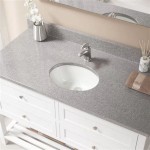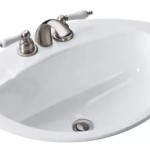```html
Bathroom Sink Double Taps: A Comprehensive Guide
Bathroom sink double taps, also known as two-handle faucets, represent a common plumbing fixture found in numerous residential and commercial settings. Their design, characterized by separate handles for hot and cold water supply, offers a distinct user experience and presents both advantages and disadvantages when compared to single-lever or mixer taps. This article aims to provide a detailed examination of bathroom sink double taps, encompassing their functionality, installation considerations, maintenance requirements, and comparative analysis with alternative faucet types.
Functionality and Operation
The core principle behind bathroom sink double taps lies in the independent control of hot and cold water flows. Each handle governs a separate valve connected to the respective water supply line. Rotating a handle opens the valve, allowing water to flow through its designated spout. The temperature of the water released is determined by the relative degree to which each handle is opened. Fully opening the hot water handle results in the highest temperature, while fully opening the cold water handle yields the lowest. Achieving a desired intermediate temperature requires careful adjustment of both handles to blend the hot and cold water streams.
Double taps typically utilize one of two primary valve mechanisms: compression valves or ceramic disk valves. Compression valves are an older technology that relies on a rubber washer being pressed against a valve seat to stop the flow of water. These valves are generally less expensive but are prone to wear and tear, leading to drips and requiring more frequent maintenance. Ceramic disk valves, on the other hand, employ two ceramic disks that precisely regulate water flow. These disks are highly durable and provide a tighter seal, resulting in fewer leaks and a longer lifespan. Although ceramic disk valves are more expensive upfront, their longevity and reliable performance often make them a more cost-effective option in the long run.
The design of double taps allows for a visual indication of which handle controls hot and cold water. Conventionally, the left handle is designated for hot water and the right handle for cold water. This convention, however, can vary depending on regional plumbing codes and installation practices. Clear markings or color-coding are often present on the handles themselves to further aid in identification, with red typically representing hot and blue representing cold. This visual cue helps prevent accidental scalding and ensures user safety.
Installation and Plumbing Considerations
Installing bathroom sink double taps is generally a straightforward process that can be accomplished by a skilled DIY enthusiast or a professional plumber. The first step involves shutting off the water supply to the existing faucet. This is typically done by closing the shut-off valves located beneath the sink. Once the water supply is cut off, the old faucet can be disconnected from the water supply lines and removed from the sink. The sink should then be thoroughly cleaned to remove any debris or sealant residue.
New double taps typically come with flexible supply lines that connect to the existing water supply pipes. These lines are often made of braided stainless steel or reinforced plastic and provide a secure and leak-proof connection. The supply lines are attached to the faucet body and then connected to the shut-off valves. It is crucial to ensure that the connections are tightened properly to prevent leaks. Plumber's tape, also known as Teflon tape, can be applied to the threaded connections to further enhance the seal.
The faucet body is then secured to the sink using mounting hardware, which typically includes a rubber gasket, a metal washer, and a nut. The gasket provides a watertight seal between the faucet base and the sink surface. The washer and nut are tightened from underneath the sink to firmly hold the faucet in place. It is important to avoid overtightening the nut, as this can damage the sink or the faucet itself.
After the faucet is installed, the water supply can be turned back on. The faucet should be checked for leaks at all connections. If any leaks are detected, the connections should be tightened further. It is also important to flush the faucet to remove any debris or air bubbles from the water lines. This is done by running both hot and cold water for a few minutes.
Plumbing codes vary by region, and it is essential to ensure that the installation complies with local regulations. Some codes may require specific types of supply lines or backflow preventers. Consulting with a qualified plumber can ensure that the installation is done correctly and safely.
Maintenance and Repair
Proper maintenance is essential to prolong the lifespan of bathroom sink double taps and prevent common issues such as leaks and reduced water flow. Regular cleaning with a mild soap and water solution can help remove mineral deposits and grime that can accumulate on the faucet surface. Avoid using abrasive cleaners or scouring pads, as these can scratch the finish.
Leaks are a common problem with double taps, particularly those with compression valves. Leaks often occur around the handles or the spout. In the case of a handle leak, the rubber washer inside the valve may need to be replaced. This is a relatively simple repair that can be done with basic tools. The water supply must be shut off before disassembling the valve. The old washer is removed and replaced with a new one of the same size and type. The valve is then reassembled and the handle tightened.
In the case of a spout leak, the O-rings or seals inside the faucet body may need to be replaced. This repair is more complex and may require specialized tools. It is often advisable to consult with a professional plumber for this type of repair. Hard water can contribute to mineral buildup inside the faucet, which can restrict water flow. Soaking the faucet components in a vinegar solution can help dissolve these mineral deposits.
Regularly inspecting the supply lines for signs of wear and tear is also important. If the lines are cracked or damaged, they should be replaced immediately to prevent leaks and potential water damage. Replacing the entire faucet may be necessary if the damage is extensive or if replacement parts are difficult to obtain.
Comparison with Alternative Faucet Types
Bathroom sink double taps offer a distinct set of advantages and disadvantages when compared to other faucet types, such as single-lever faucets and touchless faucets. Single-lever faucets, also known as mixer taps, feature a single handle that controls both the water flow and the temperature. They are generally easier to operate than double taps, as they require only one hand to adjust the water temperature and flow. However, some users find that single-lever faucets offer less precise temperature control.
Touchless faucets, which are becoming increasingly popular, use sensors to detect hand movement and automatically turn the water on and off. They offer excellent hygiene and water conservation benefits. However, they are typically more expensive than double taps and require a power source or batteries to operate. They also offer less direct control over water temperature and flow, relying on pre-set settings or electronic controls.
Double taps, while potentially requiring more deliberate adjustment to achieve the desired water temperature, offer a classic aesthetic and a sense of traditional craftsmanship. They are often found in older homes and can complement a vintage or traditional bathroom design. They are also generally less expensive than touchless faucets and may be easier to repair than single-lever faucets.
The choice between double taps and alternative faucet types ultimately depends on individual preferences, budget, and design considerations. Double taps offer a traditional aesthetic and independent control of hot and cold water, while single-lever faucets provide ease of use and touchless faucets offer enhanced hygiene and water conservation. A careful evaluation of these factors can help in selecting the most appropriate faucet for a particular bathroom setting.
```
Faucet Separate Hot And Cold Taps Bathroom Sink Water Only For Basin Double Handle Sinks Lavatory Face

Logmey 8 In Widespread Double Handle Bathroom Faucet Brushed Nickel Wiht Pop Up Drain And Hot Cold Water Hose Lmslt180ss The Home Depot

Gotonovo Bathroom Sink Faucet Deck Mount Widespread Double Mixing Tap Cross Knobs 3 Hole With Pop Up Drain

Double Wall Mounted Bathroom Sink Traditional Rectangular 50 Castellana Scarabeo 5303 By Nameeks

Gotonovo Bathroom Sink Faucet Deck Mount Widespread Double Mixing Tap Cross Knobs 3 Hole With Pop Up Drain

Double Couplet Bathroom Faucet Hot And Cold Water Basin Single Holder Dual Hole Base Wash Tap

Logmey 8 In Widespread Double Handle Bathroom Faucet Brushed Nickel Wiht Pop Up Drain And Hot Cold Water Hose Lmslt180ss

Silver Gold Bathroom Basin Sink Mixer Faucet 2 Handles 3 Holes Deck Mounted Tap

Double Faucet Sink Photos Ideas

Nickel Widespread Basin Sink Faucet Waterfall Bathroom 3 Holes Vanity Mixer Taps
Related Posts







